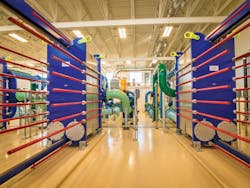About the author: Steven London is president of Steven London Associates. London can be reached at [email protected].
The Nebraska Innovation Campus (NIC), a $12 million public and private research project in Lincoln, Neb., is a combined effort of the University of Nebraska Lincoln (UNL) and the private sector. The project brings in private companies that wish to develop products and matches them with UNL researchers and infrastructure. NIC is located on the 249-acre site of the old Nebraska State Fair grounds.
NIC aspires to be the most sustainable research and technology campus in the U.S. The campus eventually will feature 2.2 million sq ft of building space that will need to be heated and cooled. Consistent with NIC’s goals, a system was designed by Olsson Associates to provide significant amounts of energy in an efficient, renewable manner to handle the needs of 1.8 million sq ft of the NIC buildings. The remainder of NIC will be heated and cooled using traditional methods.
The system, known as the Centralized Renewable Energy System (CRES), is an approach to heating and cooling buildings using heat from the city of Lincoln’s
Theresa Street Wastewater Treatment Facility (WWTF), which is conveniently located next to NIC. Currently, there are less than a dozen similar projects in the U.S. CRES is one of the largest among facilities.
Implementing the System
Olsson Associates looked at the CRES project as having three distinct parts: the work performed at the Theresa Street WWTF, including the submersible lift station and piping; the heat exchange facility; and the piping loop throughout NIC. The CRES concept took a while to develop and the city took on the effort of determining the feasibility by developing a pro forma. In addition, permitting had to be considered so the WWTF’s wastewater discharge permit would not be impacted. Design of the Theresa Street WWTF portion of the CRES started in February 2013. The remainder of the project was designed in the fall of 2013, and construction of the piping systems at Theresa Street and the NIC loop started in October 2013.
The main challenge during construction was the discovery of an old lift station below the new lift station construction site. It was not, however, a major setback. Sheet piling was installed around the old lift station, the old structure was removed, and the new structure was built.
Renewable Energy Solution
In the CRES, wastewater effluent is delivered to the heat exchange facility, where plate and frame heat exchangers heat and cool the water within the NIC piping loop. Pumps at the heat exchange facility move water through the NIC loop to the buildings for use in their heating and cooling systems. Energy use is monitored at each tenant building using a quality BTU meter that is calibrated and maintained on a regular basis.
The heat exchange facility pumps are Flygt CP 3306 110-hp submersibles with a design point of 4,947 gal per minute at 62.4-ft total dynamic head. There currently are three pumps installed; the project was designed for expandability so three more pumps can be added if necessary. The pumps utilize variable-frequency drives and the lift station operates 24 hours a day. One pump operates currently and its speed varies based on demand. As buildings are added, two pumps will operate, with the third acting as a spare. Once demand exceeds capacity of the two pumps running in parallel, more pumps will be added so that, at full build-out, five pumps will operate at up to 28 million gal per day with a sixth pump acting as a spare. Water is pumped through 2,000 ft of 30-in.-diameter pipe to the heat exchange facility, then returned to the WWTF’s discharge location, Salt Creek, through an additional 2,000 ft of 30-in. pipe.
Flygt submersible pumps, supplied by Xylem Inc., operate directly in the liquid being pumped, which means they require neither special housings nor a superstructure to support them, reducing construction costs. They are smaller than non-submersible counterparts, as the motor and hydraulics are integrated into one compact unit, resulting in smaller pumping stations that are less complex to build. Operating submerged, they take up less space, and noise and cooling problems virtually are eliminated.
Effluent water and CRES water do not mix—only thermal property is transferred between the two systems. The WWTF effluent temperature ranges from 57°F to 75°F. The maximum temperature returned to the WWTF is 85°F. The system is more efficient than geothermal systems, especially in the winter, as the effluent temperature only goes down to 57°F, while a geothermal system may drop to 40°F. This adds to the CRES’ efficiency and energy savings.
The CRES system will result in about 25% in energy savings over traditional systems (chillers and boilers) when cooling and 30% in energy savings when heating.
The CRES currently is heating and cooling one 65,000-sq-ft office building, which also includes a conference center. Another building currently under construction and greenhouses eventually will be served by the CRES later in 2015. Future locations that will use the CRES include lab and research facilities, additional office buildings, a hotel, residential housing, and retail.
Download: Here
